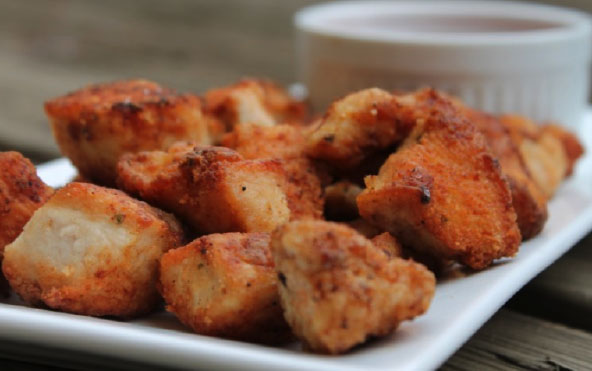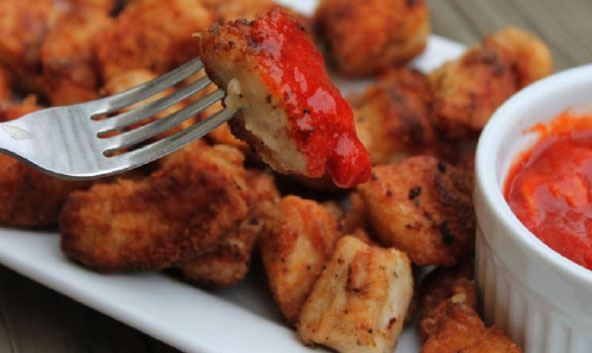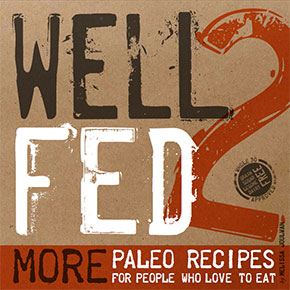Before I joined the Sunrise Farm CSA here in Vermont last summer, I'd never tried parsnips. That seems so shocking now, as I type the...
Read MoreTaylor Nichols: Paleo ChikFilA Nuggets
Since I’m still unpacking moving boxes,Taylor Nichols, the blogger behind Tayste of Paleo, is going to tell you a little bit about the mysteries of chicken labeling and why it’s important to know your local farmers. Then as a treat for doing your homework, you can take a bite of her recipe for Paleo ChikFilA Nuggets. Take it away, Taylor…

I grew up on a dairy farm in Southern Colorado so there are a lot of times that I incorporate dairy into my diet. My website and my vision are all about sustainability and acceptance of life obstacles along the way. I encourage others to understand where food comes from and to develop relationships with local farmers/providers. Small agricultural companies are the core of my roots. and I only hope that with the help of Paleo, and creating more transparency between the consumer and the farmer, more health-conscious eaters will arise.
In the mainstream market there is an immense amount of false stigmas about organic, non-organic, natural, grass-fed, and free-range products. Within my Farm to Tayble series, I hope to debunk some of these myths and help consumers understand what farming really consists of in the U.S. I hope to give the consumer a birds-eye view of what actually takes place in agriculture and what eating local really means.
I grew up with large gardens, and we processied our own livestock for meat that would serve our family all year ’round. My family emphasized the importance of seasonal eating and making sure every aspect of the animal is not only consumed, but also respected. With my agriculture background and my foodie mentality, I sometimes feel stuck between a more realistic farmer approach and the demands of the consumer.
What do I mean by this?
For example, let’s talk about free-range chicken. On TV and social media, we see brutal images of chickens, trapped in small cages and having zero quality of life. For consumers to feel better about this, we started purchasing free-range chicken, thinking that these chickens are outside roaming around and happy as pie.
But are they really?
There’s no precise federal government definition of “free range,” so the U.S. Department of Agriculture (USDA) approves these label claims on a case-by-case basis. USDA generally permits the term to be used if chickens have access to the outdoors for at least some part of the day, whether the chickens choose to go outside or not. In practice, most chickens stay close to water and feed, which is usually located within the chicken house. Chicken labeled as “organic” must also be “free-range,” but not all “free-range” chicken is also “organic.” Less than 1% of chickens nationwide are raised as “free range,” according to the National Chicken Council (NCC).
Therefore, a farmer can literally leave the door open when feeding their chickens because they know the chickens ain’t goin’ nowhere when it’s feeding time. They could consider this “free range” because the chickens had the opportunity to go outside. (For more on the issues with chicken labeling, check out this chart.)
Does it make it right? No… but that is the system.
I feel for the farmers because those are my roots. I understand the pain, heartache, and physical labor it takes to create a product from livestock. I also understand the consumers concerns, too. The consumer doesn’t want to be lied to; the consumer believes that they are actually purchasing a free-range chicken.
How do we solve this problem?
Like I preach on my blog: If the welfare of animals is important to you, get to know your farmer. Develop a relationship with local farmers and purchase their products after you understand and educate yourself about their farming techniques.
Quality of food is in your hands.
Overall, I hope this blog post helps you ask questions. I don’t mean to discourage or bring doubt; I want to bring more awareness to local farmers and help the consumer understand that sometimes labels aren’t everything they seem to be. If you do choose to purchase chicken — whether it is organic, free range, or store bought — I hope you’ll try my Paleo ChickFilA Nuggets.
Paleo ChiFilA Nuggets
These nuggets taste just like the real deal. I love this recipe because it definitely brings out the WOW factor. They are crunchy, salty, and packed with flavor. — Taylor
NOTE: Be sure to read the comments on this post! Lots of great suggestions for the nuggets.
Ingredients:
2 large boneless, skinless chicken breasts
1-2 cups of pickle juice (enough to submerge the chicken breast)
paprika
onion powder
garlic powder
salt and ground black pepper
1/2 cup tapioca flour
1/4 cup coconut oil
Directions:
Begin my marinating your chicken in the pickle juice. You want to make sure the chicken is fully immersed in the pickle juice. Refrigerate for at least 1 hour
When the chicken is marinated, place the tapioca flour in a small bowl. Set aside
Cut the chicken into bite-size pieces and season with salt, pepper, garlic powder, and onion powder. I fully cover the chicken with the seasonings. Flip over and season the other side.
Lightly roll the chicken in the tapioca flour. Try not to handle the chicken too much; this can make the flour and seasonings fall off.
Place the coconut oil in a medium sauce pan or non-stick skillet and heat over medium-high heat. Add the nuggets in a single layer and let cook for about 3 minutes on each side. Keep an eye on ’em! When they’re browned on the bottom, flip over and brown the other side.
Remove from the pan and season with more salt. Serve with a dipping sauce, like Paleo Sriracha, Awesome Sauce, or Ranch Dressing.
Taylor Nichols is the blogger behind Tayste of Paleo. You can also find Taylor on Facebook, Instagram, Pinterest, and Twitter.
Still hungry? Try these
As a kid, I never liked ketchup, an opinion that wasn't helped by the fact that my brother ate a ketchup-and-peanut-butter sandwich once to gross...
Read More






Can you taste the pickle juice?
The pickle juice acts as a brine to make the chicken tender and flavorful. If you’re concerned it will be too pickle-y, you can use water and salt instead, but it will be less flavorful.
Ok, thank you! I don’t mind it so much as my kids might. 🙂
Any reason for leaving the breast whole prior to brining? If they’re cut, you would be able to reduce the brining time and the salt from the brine would permeate the meat faster.
I suppose you also run the risk of very dried out and very salty pickle-y chicken nuggets though.
Not sure why Taylor opted for keeping the breasts whole — but I don’t see any reason not to cut it first. Happy cooking!
Tell you what.. I’ll make these this week using both the whole breast and cut methods. I’ll report back with my findings as soon as I can!
Awesome! I love science!
Alright! I’ve done probably waaaay to much science to these and have learned the following. I used two chicken breasts for each test, over the course of a few weeks.
1. If you want more pickle flavor, cut the chicken into pieces and reduce the brine time by a little more than half.
2. Brines with higher sodium content will result in more tender chicken. If you’re cutting it up, make sure to reduce brine times, or it can turn dry and salty on you quick!
3. If you’re not making your own brine, try to find pickles in the deli section instead of the “pickle aisle”. Brands like Grillo’s are AWESOME for this recipe. Yes, they’re $6.99 for about a dozen pickle spears. But they are amazing, and it gives you an excuse to eat a jar of pickles.
4. Be careful with tapioca flour! Tapioca flour is a tricky starch. It can get gloopy quickly. If this is your first time making them, cook one piece at a time to get the timing down. If the “batter” starts to bubble, you’ve cooked it too long.
5. Don’t dry them on a paper towel, plate or rack. Put them on a plate, in a single layer. Tent the plate with foil and let them rest for 5 minutes. The batter can be delicate, and will stick to a porous surface.
6. Not gonna lie – I really want to make Marsala with this base. Maybe without the pickle brine though. 🙂
The second I saw pickle juice on the ingredient list I was like “yep, that’s ChikFilA.” If you’ve eaten ChikFilA you know that the chicken is moist and briny but not “pickly.” I’ve marinated whole chickens in pickle juice and roasted them, and the flavor is unbelievably good.
Thanks for the insight on the pickle juice!
so, i tried these this morning (yes, had them today for b’fast, lunch and dinner!) and they were yummy!
re the whole breast vs. pieces brining issue: i did mine in pieces, was planning to cook them yesterday, but didn’t. so, they ended up brining for ~24 hrs. thought they were moist enough and not dry. this could have bee helped w/ the tapioca flour/coconut oil coating.
re the pickle juice taste – i think since i ‘knew’ pickle juice was used, i could taste it, but the flavor didn’t seem overpowering – even w/ the EXTENSIVE brining time.
Mel – LOVE your blog and recipes. a special thx for the 30 shopping/cooking/meal plans. i’ve learned so much from you!! you are amazing – thank you for sharing your gifts.
Thanks for the feedback on Taylor’s recipe and for your lovely compliments on my blog and recipes. I’m so happy you like them!
I’m new to your site but have used it (and I bought wellfed2) to get me thru The Whole30. I never thought I could do it but it’s much easier than I anticipated with your recipes. Anyway today was the 1st in a LONG time I craved a cruch (I ate chips daily for cruch before TW30) so I made these. They’re soooo good!!! Shout out to Taylor!
I made your sb&j burgers yesterday-LOVE!!! I’ll never use ketchup mayo n mustard again on a burger! Thanks for sharing all your paleo knowledge!!
I’m so happy this recipe came in handy! Glad you like the SB&J burgers, too! YAY!
Melissa,
I just purchased tapioca flour and coconut flour…where do you store yours and about how long does it last? This is my first time using these ingredients 🙂
I store my tapioca flour on a pantry shelf and keep the coconut flour in the refrigerator. They have a shelf life of 3 years.
I don’t have any tapioca flour in the house, but I do have almond meal and coconut flour. Do you think either of those would work in this recipe? They look too good to *not* make immediately! 🙂
In my crispy chicken livers recipe (http://meljoulwan.com/2012/01/08/crispy-spiced-chicken-livers/), I use coconut flour, so that should work in Taylor’s recipe.
Thank you for the answer! These are going in my menu plan this week. 🙂
My 7 year old loves these. It’s such a great compromise. Thanks!
Hi Melissa, Is tapioca flour considered a grain? What is tapioca? I am considering doing the Whole30 in September and am collecting some recipes ahead of time! 🙂
Tapioca is a starch, so in small quantities like this, it’s just fine, paleo-wise. I think these are just fine for a Whole30, as long as you don’t think they’ll trigger overeating for you.
Where do you get the pickle juice? Just pour it off of a jar of pickles or get some kind of a mix to make it? Starting Whole 30 today for the first time!
Yep! Just get some from your favorite jar of pickles — provided there are no added sugars or other suspect ingredients, if you’re Whole30-ing.
Hi there, we are making these tonight and we are super excited! Just wondering if you or Taylor could offer some approximate measurements of the paprika, garlic powder, onion powder, salt, and pepper. I have absolutely NO intuition for proportions on stuff like that and would love a hint. Also, we like to double and triple recipes here and thought folks might like to know that a 24oz jar of the Whole Foods Kosher Dill pickles provides enough juice to brine about five to six breasts. Thanks!!
I’ll try…
Salt: As a general rule of thumb, you use 3/4 teaspoon salt per 1 pound of meat, but since these are marinated in pickle juice, I’d start with 1/4 teaspoon salt.
Pepper: I usually go for 1/2 as much pepper as salt, so that would be 1/8 teaspoon, although I like “fried” chicken kind of peppery, so you might go for 1/4 teaspoon pepper.
Garlic: I usually recommend 1 clove garlic per pound of meat for a mild flavor where you don’t want garlic to be the top note. And 1/8 teaspoon garlic powder usually equals about 1 garlic clove. I’d use the same for the onion powder.
Paprika: I’d say 1/4 to 1/2 teaspoon.
And just in case you don’t have a 1/8 teaspoon measuring spoon, that’s equivalent to a generous pinch with your fingers.
These were AMAZING!! They were so good that between the nibbling I did and the nibbling my kids did, they didn’t even make it to the table, totally gone before I could even put out the plates. The spice mix I wound up using was: for every 2 breasts, 1 tbs paprika, 1 tsp garlic powder, 2 tsp onion powder, 1.5 tsp salt, 1/2 tsp pepper. Thanks for such a great recipe! My recipe
Thanks for getting back to me so quickly, looks like we crossed posts. We will try your spice mix next time, which will be very soon I’m sure! I hit send too soon, but I was going to say my recipe book is getting stuffed to the brim with your recipes. Just about everything we make from your website becomes a family favorite!
did anyone else’s oil get all foamy when they put the chicken in?
could these be done in the oven rather than fried? if so what do you suggest for temp and time?
Try 425F for 20-25 minutes.
awesome thank you!with 5 mouths to feed that would have been a Lot of batches
Does the tapioca flour fall under the Whole30 compliant plan? I thought we could only use Almond flour as a binding agent.
I’m not sure if tapioca flour in this way is Whole30 approved. If you’re concerned, my recommendation is wait until after your Whole30 to eat these, or replace the tapioca starch with coconut flour.
I used arrowroot powder and it worked great!
Hi, I was planning to marinate these overnight but am worried they’ll get dried out or too salty. (I’m a brining novice). Any suggestions or guidance for max brining time? BTW, I’ve never made these with the tapioca/almond/coconut flour coating and they are still delicious! Also, you can buy pickling powder at the grocery store to make your own pickle juice, which helps keep pickles from going to waste.
You can brine overnight; it’ll be just fine.
Looking forward to trying this! However, I notice whenever I try cooking with tapioca flour or even arrowroot it 1. never browns up nice for me and 2. It just gets pasty like for me…. so I’m always hesitant to use either. Am i doing something wrong maybe?
It *might* be that your cooking fat isn’t hot enough. Try letting the pan heat up a bit longer, but keep an eye on whatever you’re cooking so it doesn’t burn.
If I want to try baking them like somebody asked about above should I use a foil lined, parchment paper, or naked pan? I have failed with tapioca coated stuff too so I am a little nervous to just experiment.
Parchment paper is probably your best bet to avoid sticking. Good luck!
When handling the chicken pieces, so that the seasonings and flour doesn’t fall off, try using chop sticks. My wife is from China, and I’ve taken to using them in all sorts of cooking. You can manipulate the chicken chunks very easily, from the seasoning to the flour to the frying pan, with a very small ‘footprint’ on the pieces.
Thanks for sharing this awesome tip!